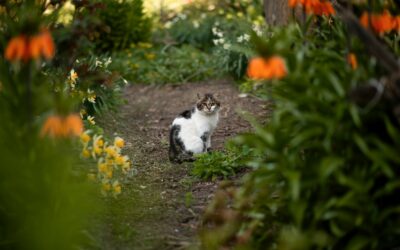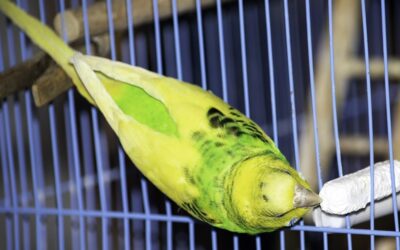Anyone who’s ever seen the effects of catnip on a feline has probably wondered the same thing: What does catnip do for a cat? What is it about this plant that induces an almost drugged state in our furry friends, why does it affect some more than others and should you be offering catnip to your cat?
Let’s go into what catnip does for a cat and a whole bunch of other fascinating facts about this plant and its effects.
What is catnip?
Catnip is the common name for Nepeta cataria, an unassuming plant that looks somewhat like a nettle and grows small blueish to purple flowers. It emits a strong scent and tastes somewhat minty. The plant is used in gardens (bees and butterflies love it!) but, of course, is best known for the effects of Nepetalactone, its essential oil.
Nepetalactone is what makes cats (as well as some other felines, like lions) act funny. Not that this is its main function: for the plant itself, Nepetalactone acts as an insect repellent. In humans it can have calming effects (more about that later) and it has long been used in traditional medicine in places like China.

What does catnip do for a cat?
The effects of catnip on a cat vary greatly per individual, with about 60% being affected by the plant (Espín-Iturbe et al., 2017). Behaviors exhibited upon exposure, which usually involves plenty of pawing, licking, rubbing and chewing, can include:
- Rolling
- Drooling
- Vocalizing
- Purring
- Falling asleep
- Lack of activity (such as sitting very still)
A 2017 study showed that 20% of affected cats become active (rolling over, etc.), while 80% is passive, for example sitting in a “sphinx-like position” (Espín-Iturbe et al., 2017). There can also be some negative effects, like an aggressive or anxious response. In kittens and senior cats, a larger percentage doesn’t respond at all.
It seems that whether a cat is affected by catnip or not depends on genetics, although it’s also been suggested that age, sex and neutering can play a role.
But why? What does catnip do for a cat and how? Well, it all takes place in the nose. Although cats will tend to try to eat catnip if you offer it, Nepetalactone actually brings about a reaction through receptors in the olfactory system.
Did you know? If your cat is among the ones not sensitive to catnip, or responds with anxiety or aggression, there are actually alternatives. According to one study, 80% of cats responded to silver vine (a type of kiwi bush), 50% to valerian (also used as a sleeping aid in humans) and 50% to Tatarian honeysuckle (Bol et al., 2017). This included cats who didn’t respond to catnip!
How to use catnip
As pet owners, we’re always looking for ways to enrich our furry friends’ lives and make them more exciting. As Bol et al. noted in their 2017 study, olfactory enrichment is something often overlooked when it comes to cats. Basically, we could be stimulating our cats’ noses more, and catnip is a prime example of one way to do so. After all, the plant isn’t considered addictive nor have harmful effects been noted.
Catnip is available in a few basic forms:
- You can buy a catnip plant at most garden centers and grow it in your garden or on your balcony. This way you’ll have a steady supply of fresh catnip, which, by the way, has a stronger effect than the dried stuff.
- Dried catnip.
- Catnip-infused cat toys.
- Catnip in spray form.
You can try getting your cat interested in new items (like scratching posts, litter boxes), environments or foods using catnip. You can also use it to calm an anxious cat down, for example by placing some in the carrier when it’s time for a vet visit. No need to use a lot: in some studies, as little as 500mg (way less than a teaspoon) of dehydrated catnip was given and that worked perfectly fine (Espín-Iturbe et al, 2017). Not surprising, given how sensitive cat noses are!
Aside from entertaining your average housecat, Bol et al. mention a few more good reasons to use catnip in their study. Consider how it helps with the following, for example:
- Training: You can use catnip when you’re training your cat instead of treats as a reward.
- Animal shelters: Catnip can help keep even fearful cats happy in a shelter environment and even make them more attractive to potential new cat parents, as they’ll express their playfulness and be more relaxed.
- Population control: Trapping feral cats for trap/neuter/release programs can be made easier by luring them with catnip.
Did you know? No worries about your cat overdosing on catnip: they’re usually only interested in it for around 15 minutes. After this, olfactory fatigue sets in. This is a phenomenon that makes cats’ (and human) noses less sensitive to smells after being exposed to them for an extended period of time – the same reason you stop smelling your own perfume after a while.

Catnip for humans
Yep, as mentioned earlier, catnip also affects humans. It has long been a part of traditional medicine in some regions, although it has now fallen out of favor due to more effective medication being available. That doesn’t mean humans don’t consume it anymore, though: people still drink, chew and smoke the stuff for its effects on the brain.
In a 1990 article, author Grognet describes sources mentioning that catnip acts as both a soothing agent and a stimulant, not dissimilar to marihuana, and that it has mild hallucinogenic effects. Note that we’re not suggesting you roll a catnip cigarette here, although this practice was apparently popular for a while in the 1960s.
Conclusion
To conclude, if you share your home with a cat, offering some catnip is worth a try. It can help with anxiety and make new things more interesting, but it’s also just a great way to show your feline friend a good time with no risk factors attached. And perhaps most importantly… watching a happy cat go crazy on catnip is priceless!
Sources







